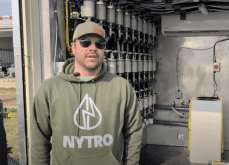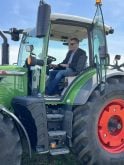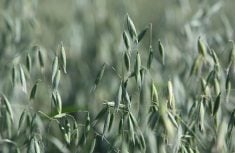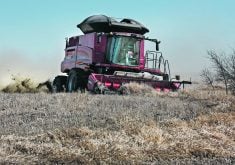Nisku, Alta. – Craig Shaw is part of a growing group of farmers coming to grips with the idea that the current margin squeeze may be here to stay.
He’s convinced that better pro-
duction efficiency will be the key to survival.
“We have a strong emphasis on improving our marketing skills, but there is also recognition we need to look at other avenues of improvement,” Shaw said about the management practices on his 2,500-acre farm near Lacombe Alta.
“We need to manage input costs while maintaining and increasing yields.”
Read Also

VIDEO: Ag in Motion documentary launches second season
The second season of the the Western Producer’s documentary series about Ag in Motion launched Oct. 8.
His immediate attention is focused on two big input areas where he has pencilled out significant potential gains: fertilizer and herbicides. He said the numbers in his projections are realistic and the benefits are attainable. The challenge will be to harness the technology that will give him better efficiency in fertility and herbicide management.
Because nitrogen is his biggest fertilizer expense, this is where he expects the best return on investment. In the hypothetical quarter section field in his computer model, Shaw thinks he can realistically reduce nitrogen application by 20 percent on 40 percent of the land without reducing yields on those 64 acres.
If nitrogen is 44 cents per pound and his typical application rate is 80 lb. per acre, he would have a cost saving of $7.04 per acre or $450.56 per quarter section.
In his model quarter, which is designed to be typical of his farm, he thinks 20 percent of the acres can be prone to lodging because of too much nitrogen.
If lodging in those 32 acres creates a yield loss of 33 percent on a 90 bushel barley crop, it works out to a loss of $75 per acre if barley sells at $2.50 per bu. The lost revenue on those 32 acres works out to a $2,400 loss on the entire quarter.
Combine efficiency is another factor in his software. If the cost of running a combine with a 30-foot header is $180 per hour, slowing the machine from 6.5 km-h down to three km-h because of lodging problems will push the combine cost up by $11 per acre. Those 32 lodged acres increase the combine cost by $350 for the quarter section.
“With the reduced yield and the additional cost, our costs go from about 14 cents per bu. on standing 90 bu. crop to about 41 cents per bu. on 60-bushel lodged crop,” Shaw said.
“Too much nitrogen can cost you a lot of money.”
He said there is really never a typical year; no two years are ever alike and plans don’t always turn into reality. Nonetheless, the quarter section in Shaw’s computer model indicates there is potential for an extra $3,200 profit just through better nitrogen management.
In his weed control program, Shaw said wild oat chemical at about $15 per acre is his largest overall cost. Experience has taught him that many fields require only one-third of the acres to be sprayed. Simple math tells him that if he did not spend that $15 per acre on 100 acres, he would save $1,500 on the quarter.
Quackgrass and thistle cause major yield reductions and chemicals to control them cost $20 per acre.
However, Shaw said they only need to be applied to about 20 percent of the acres. He said if he can pinpoint those acres for a targeted spray operation, he can reduce the cost of that quarter section by $16 per acre, or $2,560 on the quarter.
“With broadleaf control, we may be able to save money by targeting different herbicides to different parts of the field. While this likely requires other technology such as chemical injection and dual tank sprayers, it might be practical if the financial incentive is there.”
Shaw said he is reviewing his farm’s entire operation this winter.
“We’re right now trying to figure out how we should break our fields down into management units,” which are based on soil tests, topography and yield maps.
“We’re also looking at charting the electrical conductivity. Like most farms, we have variable soil types and we can no longer treat them all the same.”
Moisture isn’t normally considered a limiting factor in the Lacombe area, but on lighter land, moisture can limit production. Shaw wants to make sure he’s not wasting nitrogen on those acres.
Electrical conductivity can help identify the potential of the different soils.
“Aerial photography is another thing we need to get serious about. If a person doesn’t want to photograph his fields with a remote control airplane, then it’s worth finding a neighbour with an airplane and paying them the $75 an hour or whatever it might cost.
“Aerial photos can confirm what your various maps tell you and they can help spot things you might otherwise miss. I think aerials are of some help in the fertility program, but I think they will have greater value when it comes to fine-tuning our herbicide program.”















